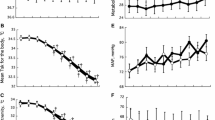Abstract
Sweating and vasodilatation in the cutaneous circulation were investigated during passive body heating in eight borderline hypertensive subjects and in eight normotensive controls, matched for age, sex and body mass. Blood flow through the finger and forearm was examined in relation to changes in oral temperature; blood pressure, heart rate and sweating in the forehead and forearm were also measured. Systolic blood pressure decreased in borderline hypertensive subjects during the early stages of heating and then returned to baseline, but increased in normotensives. Increases in skin blood flow and decreases in cutaneous vascular resistance were similar in both groups. Thus, cutaneous vasodilatation during moderate body heating did not differ between normotensive subjects and subjects with mildly elevated blood pressure. These findings do not rule out attenuation of cutaneous vasodilatation in mildly hypertensive subjects during more intense heating.
Similar content being viewed by others
References
Folkow B. Physiological aspects of primary hypertension.Physiol Rev 1982;62: 347–504.
Julius S. Autonomic nervous system dysregulation in human hypertension.Am J Cardiol 1991;67: 3B-7B.
Hamet P, Malo D, Hashimoto T, Tremblay J. Heat stress in hypertension.J Hypertens 1990;8(suppl 7): S47-S52.
Julius S. Borderline hypertension. An overview.Med Clin N Am 1977;61: 495–511.
Rowell LB. Reflex control of the cutaneous vasculature.J Invest Dermatol 1977;69: 154–166.
Simeone FA, Cranley JJ, Grass AM, Linton RR, Lynn RB. An oscillographic plethysmograph using a new type of transducer.Science 1952;116: 355–357.
Fellmann N, Grizard G, Coudert J. Human frontal sweat rate and lactate concentration during heat exposure and exercise.J Appl Physiol 1983;54: 355–360.
Weiner JS. The regional distribution of sweating.J Physiol 1945;104: 32–40.
Drummond PD. Effects of body heating and mental arithmetic on facial sweating and blood flow in unilateral migraine headache.Psychophysiology 1991;28: 172–176.
Julius S, Esler M. Autonomic nervous cardiovascular regulation in borderline hypertension.Am J Cardiol 1975;36: 685–696.
Engel BT, Gaardner KR, Glasgow MS. Behavioral treatment of high blood pressure. I. Analyses of intra- and interdaily variations of blood pressure during a one-month baseline period.Psychosom Med 1981;43: 255–270.
Drummond PD. Personality traits in young males at risk for hypertension.J Psychosom Res 1982;26: 585–589.
Kenney WL, Kamon E, Buskirk ER. Effect of mild essential hypertension on control of forearm blood flow during exercise in the heat.J Appl Physiol 1984;56: 930–935.
Johnson JM, Rowell LB. Forearm skin and muscle vascular responses to prolonged leg exercise in man.J Appl Physiol 1975;39: 920–924.
Kenney WL, Johnson JM. Control of skin blood flow during exercise.Med Sci Sports Exerc 1992;24: 303–312.
Johnson JM, Rowell LB, Brengelmann GL. Modification of the skin blood flow-body temperature relationship by upright exercise.J Appl Physiol 1974;37: 880–886.
Brengelmann GL, Johnson JM, Hermansen L, Rowell LB. Altered control of skin blood flow during exercise at high internal temperatures.J Appl Physiol 1977;43: 790–794.
Wyss CR, Brengelmann GL, Johnson JM, Rowell LB, Niederberger M. Control of skin blood flow, sweating, and heart rate: role of skin vs. core temperature.J Appl Physiol 1974;36: 726–733.
Kenney WL, Kamon E. Comparative physiological responses of normotensive and essentially hypertensive men to exercise in the heat.Eur J Appl Physiol 1984;52: 196–201.
Pescatello LS, Mack GW, Leach CN, Nadel ER. Thermoregulation in mildly hypertensive men during beta-adrenergic blockade.Med Sci Sports Exerc 1990;22: 222–228.
Scherf HP, Meffert H, Baumler H, Dittmann K, Siewert H, Strangfeld D, Winterfeld HJ, Hecht HC, Schuhmann E, Sonnichsen N. Effect of a single mild infrared A hyperthermia on body temperature, heart rate, blood pressure and blood viscosity in healthy probands and patients with stage I and II arterial hypertension.Dermatol Monatsschr 1989;175: 733–740.
Brennan PJ, Greenberg G, Miall WE, Thompson SG. Seasonal variation in arterial blood pressure.Br Med J 1982;285: 919–923.
Hata T, Ogihara T, Maruyama A, Mikami H, Nakamaru M, Naka T, Kumahara Y, Nugent CA. The seasonal variation of blood pressure in patients with essential hypertension.Clin Exp Hypertens [A] 1982;4: 341–354.
Author information
Authors and Affiliations
Rights and permissions
About this article
Cite this article
Drummond, P.D. Thermoregulatory response to passive body heating in borderline hypertension. Clinical Autonomic Research 3, 233–238 (1993). https://doi.org/10.1007/BF01829011
Received:
Accepted:
Issue Date:
DOI: https://doi.org/10.1007/BF01829011




